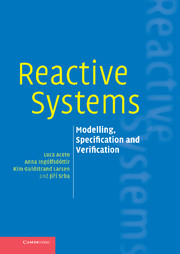Book contents
- Frontmatter
- Contents
- Figures and tables
- Preface
- I A Classic Theory of Reactive Systems
- 1 Introduction
- 2 The language CCS
- 3 Behavioural equivalences
- 4 Theory of fixed points and bisimulation equivalence
- 5 Hennessy–Milner logic
- 6 HML with recursion
- 7 Modelling mutual exclusion algorithms
- II A Theory of Real-time Systems
- Appendix A Suggestions for student projects
- References
- Index
6 - HML with recursion
from I - A Classic Theory of Reactive Systems
Published online by Cambridge University Press: 17 March 2011
- Frontmatter
- Contents
- Figures and tables
- Preface
- I A Classic Theory of Reactive Systems
- 1 Introduction
- 2 The language CCS
- 3 Behavioural equivalences
- 4 Theory of fixed points and bisimulation equivalence
- 5 Hennessy–Milner logic
- 6 HML with recursion
- 7 Modelling mutual exclusion algorithms
- II A Theory of Real-time Systems
- Appendix A Suggestions for student projects
- References
- Index
Summary
Introduction
An HML formula can only describe a finite part of the overall behaviour of a process. In fact, as each modal operator allows us to explore the effect of taking one step in the behaviour of a process, using a single HML formula we can only describe properties of a fixed small part of the computations of a process. As those who solved Exercise 5.13 have already discovered, how much of the behaviour of a process we can explore using a single formula is entirely determined by its so-called modal depth, i.e. by the maximum nesting of modal operators in it. For example, the formula ([a]〈a〉ff) ∨ 〈b〉tt has modal depth 2, and checking whether a process satisfies it involves only an analysis of its sequences of transitions whose length is at most 2. (We will return to this issue in Section 6.6, where a formal definition of the modal depth of a formula will be given.)
However, we often wish to describe properties that describe a state of affairs that may or must occur in arbitrarily long computations of a process. If we want to express properties such as, for example, that a process is always able to perform a given action, we have to extend the logic. As the following example indicates, one way of doing so is to allow for infinite conjunctions and disjunctions in our property language.
Information
- Type
- Chapter
- Information
- Reactive SystemsModelling, Specification and Verification, pp. 102 - 141Publisher: Cambridge University PressPrint publication year: 2007
